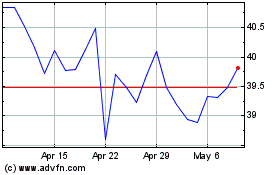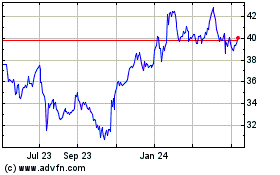Verizon conquers remaining Dead Zones through Satellite with help of Test Man and Buzz Aldrin
01 February 2025 - 2:30AM

Today, Verizon is pushing the boundaries of satellite and
terrestrial telecommunications convergence. Satellites are no
longer reserved for the extraordinary—they are woven into the
everyday, and are being used to help connect and power customers’
lives.
A lot has changed since 2014 when Verizon’s famous test man
roamed the country asking “Can you hear me now?” Now he’s back, and
reaching the limits of space with the help of American icon and
astronaut Buzz Aldrin. They’re partnering to show how America’s
largest network just got better.
“Fifty-six years ago I was
one of the select few that made it into Space and the first team to
help America conquer the moon,” said Buzz Aldrin, General USAF,
Doctor of Astronautics. “Back then, Space was the great unknown,
and now we’ve never been closer to it. I can’t look up in the sky
without seeing a satellite fly by. It’s remarkable to see how far
the human race - and technology - has come.”
“It’s been 10 years since I
last asked America “Can you hear me now?,” said Paul Marcarelli,
the Original Verizon Test Man. “Back then dead zones were
everywhere and it’s safe to say today they are only in the most
remote places like the dark side of the moon. Verizon’s always been
on a mission to give its customers the very best experience,
anticipate their changing needs and drive innovation. Satellite is
for sure the next frontier.”
Freedom to message anywhere with
satellite-power. Verizon engineers are relentlessly
focused on providing the most reliable network experience for
customers. Verizon’s network covers more than 99% of where people
live, work and play, leaving very few places throughout the country
where customers can’t connect. With the addition of satellite
back-up to Verizon’s already robust network, Verizon is making the
largest network even better.
Satellites play a crucial role in making connectivity with
Verizon even more reliable, enabling text messaging in the few
areas where traditional terrestrial-based cellular networks might
not reach. Here’s how:
- Customers with select devices have access to satellite
messaging features to enhance connectivity in areas without
cellular coverage, allowing customers to send an emergency SOS
message and provide their location.
- Verizon is collaborating with Skylo to make satellite messaging
features and location detection available for customers with select
Android devices.
- And recently, AST SpaceMobile and Verizon announced a strategic
partnership with a commitment of $100 million from Verizon, to
provide direct-to-cellular AST SpaceMobile service when needed for
Verizon customers. The combination of Verizon’s highly
reliable terrestrial mobile network, use of the multi-operator 850
Mhz band and AST’s commercial satellite array in low Earth orbit,
is planned to enable cellular consumers to stay connected wherever
they are, anywhere in the continental United States.
This week, the Federal Communications Commission (FCC) has
granted AST Special Temporary Authority (STA) authorizing beta
service in the United States. This approval enables AST
SpaceMobile’s first five commercial BlueBird satellites, operating
in low Earth orbit today, to test satellite connections with
Verizon smartphones supporting voice, full data and video
applications, and other native cellular capabilities, without the
need of any specialized software or device support or update.
Satellites provide reliable service in emergency
situations.Verizon utilizes nearly 300 satellite-based
portable network assets to ensure connectivity where fiber cables
are unavailable or compromised. These assets provide temporary
network access for first responders and in areas with limited
permanent infrastructure, or for linking cell sites to the broader
network when fiber cables are compromised due to power outages or
physical damage.
Satellite connections speed up delivery of service to
customers in remote areas.Verizon uses satellite
connections as backhaul for cell sites in remote areas (like
forests and mountain tops) where traditional wired connections like
fiber are not yet available. Satellite connections can be set up
quickly compared to laying fiber, particularly in areas with
significant geographical or logistical barriers. This rapid
deployment is a useful solution while fiber optics is being planned
and deployed. This allows cell sites to be operational and provide
service while waiting for the installation of a more robust and
high-capacity connection.
* "Largest network" based on total postpaid phone connections
publicly reported by Verizon, T-Mobile and AT&T during the
third quarter of 2024.
Verizon Communications Inc. (NYSE, Nasdaq: VZ) powers and
empowers how its millions of customers live, work and play,
delivering on their demand for mobility, reliable network
connectivity and security. Headquartered in New York City, serving
countries worldwide and nearly all of the Fortune 500, Verizon
generated revenues of $134.8 billion in 2024. Verizon’s world-class
team never stops innovating to meet customers where they are today
and equip them for the needs of tomorrow. For more, visit
verizon.com or find a retail location at verizon.com/stores.
VERIZON’S ONLINE MEDIA CENTER: News releases, stories, media
contacts and other resources are available at verizon.com/news.
News releases are also available through an RSS feed. To subscribe,
visit www.verizon.com/about/rss-feeds/.
MEDIA CONTACT:Karen
Schulz864.561.1527Karen.schulz@verizonwireless.com
Verizon Communications (NYSE:VZ)
Historical Stock Chart
From Jan 2025 to Feb 2025

Verizon Communications (NYSE:VZ)
Historical Stock Chart
From Feb 2024 to Feb 2025
